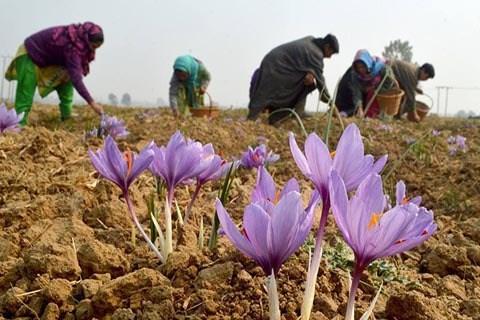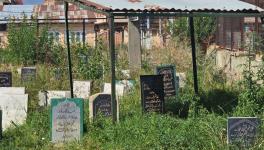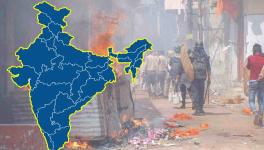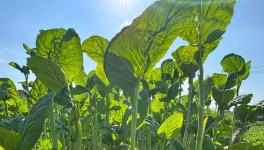Kashmir Saffron Farmers Suffer Despite Bumper Crop

Image Courtesy: greater Kashmir
Srinagar: Battling climate change and crisis driven summers, saffron growers in Kashmir have been caught up for years with uneven produce and market behaviour, concerns which continue to mar the farmers despite this year’s bumper crop.
After being hit by severe dry spell for the last two years, the production of saffron—also known as golden spice—surged this year, bringing respite to saffron farmers. However, the saffron producers claim that they often don’t get any benefits, irrespective of the produce, due to intermediaries who control the saffron trade.
Director of Agriculture Department, Syed Altaf Aijaz Andrabi, is also of the opinion that saffron growth has not been fully realised with regards to the potential it has, mainly because of the monopoly developed by local trade intermediaries. “They have monopolised the trade in the region which has kept farmers away from getting the benefits despite high yield,” Andrabi told NewsClick.
This year the growers, Andrabi says, have harvested about 17 tonnes of saffron produce which is much higher as compared to six tonnes of produce from last year. According to the president of Saffron Growers’ Association, Abdul Majeed Wani, adequate rainfall boosted this year’s production.
Saffron, a trademark spice from Kashmir, is cultivated in over 3,715 hectares of land in the region, making it the second largest producer in the world after Iran where saffron cultivation extends over 30,000 hectares of land.
Also read: Fall of Apple in Kashmir
In Kashmir, the major chunk of the cultivation is done in Pulwama district in around 3,200 hectares while in Srinagar and Budgam, it is cultivated in around 170 and 330 hectares of land, respectively. Apart from Kashmir valley, saffron is also grown in Kishtwar region in around 150 hectares of land.
A Rs 700 crore industry, saffron is one of the costliest spices sold at about Rs 3 lakh per kg in the Indian markets and at even higher rates of upto Rs 5 lakh per kg in the international markets. Considered to be the best quality globally, Kashmiri saffron also fetches better prices than other brands including those from Iran. Saffron farmers, however, usually sell their produce anywhere between Rs 1.3-3 lakh per kg, as the prices are often dictated by middle-men, thus, exploiting the farmers and preventing them from earning any real benefits.
Adequate rainfall during September and October months, and early snowfall in November this year is being seen by growers and agriculture officials as a blessing to the saffron growth, which requires a complex temperature regime to achieve its full bloom. The crop is usually harvested in late October and in the first week of November.
Known for its impressive cosmetic and medicinal value, the demand for saffron in the Indian market is estimated to be around 100 tonnes. Growers in Kashmir, however, allege that traders engage in adulteration in the Indian market, by mixing a portion of Kashmiri saffron with large quantities from Iranian quality and sell it under Kashmir’s trademark quality.
Wani says the crop, which is susceptible to natural calamities, should be provided with “crop insurance”. “The farmers should also be given compensation in the wake of any natural calamity,” he adds.
Earlier in Novermber, the Finance Ministry had asked the National Bank for Agriculture and Rural Development (NABARD) to provide ground-level facts and figures, such as production quantity and surplus produce of saffron to work on a possible market intervention plan by the government.
To boost saffron farmers in the valley, the government in 2010 launched the Rs 400 crore worth National Saffron Mission to rejuvenate the cultivation of saffron crop. However, there are contrary claims as far as the effect and implementation of the plan is concerned. On one side, there are claims that the plan has served most of its purpose in increasing the per hectare yield in Kashmir and introducing new technology in farming practices. On the other hand, there are allegations that the mission has remained ineffective with regards to providing irrigation to the lands under saffron cultivation as well as against the continued pressure from land mafia, which is responsible for ‘mindless construction and selling’ of saffron land, especially in Pulwama area of Pampore.
Also read: ‘Declare Heavy Snowfall in Kashmir as National Calamity, Compensate Farmers’
Saffron growers say that government support in any form to revive the loss-hit saffron industry would be more than welcome. After expecting a bumper crop this year, growers were hit by the season’s first snowfall on November 7, which caused 40% drop in annual production.
Get the latest reports & analysis with people's perspective on Protests, movements & deep analytical videos, discussions of the current affairs in your Telegram app. Subscribe to NewsClick's Telegram channel & get Real-Time updates on stories, as they get published on our website.
























